The Intel Core Ultra 7 155H Review: Meteor Lake Marks A Fresh Start To Mobile CPUs
by Gavin Bonshor on April 11, 2024 8:30 AM ESTASUS Zenbook 14 OLED UX3405MA: Battery & Thermal Performance
While battery life is normally one of the key aspects of a notebook computer to begin with, Ultrabooks and other thin-and-light laptops in particular live and die by battery life. As they're designed to provide much longer battery life in order to enable (and sustain) on-the-go computing, while lacking the space and weight to pack a large 80 Wh+ battery, thin-and-light laptops live on the knife's edge in delivering on their battery life claims.
With Intel taking a mobile-first path with their Meteor Lake architecture, power consumption and battery life is an area where the architecture is intended to shine. And especially in the case of the ASUS Zenbook, which is an Evo-certified laptop, there are Intel co-engineering resources and performance requirements that come with it. Particularly in the case of battery life/energy efficiency.
The ASUS Zenbook 14 OLED UX3405MA comes with a battery rated at 75 Wh, with a supplied 75 Wh Type-C AC adapter for charging. Given that the Intel Core Ultra 7 155H has many associated TDP values from Intel, e.g., 115 W maximum turbo TDP, 28 W base TDP, and a MAP TDP of 65 W. We know from our power analysis that this notebook operates at between 28 and 65 W, which should give this particular Ultrabook some swing regarding overall battery life.
UL Procyon: Video Playback
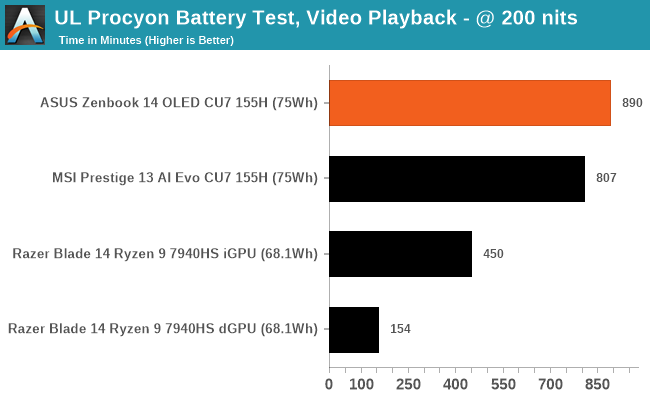
Using UL Procyon's video playback benchmark with the brightness calibrated to 200 nits, we can get a baseline battery life figure. UL Procyon's video playback test incorporates multiple HD videos and runs until the battery is empty. This includes 1080p YouTube quality video at 30 fps, with square pixels at NTSC level, and VBR 2 pass bitrate encoding with 10 Mbps.
Within the UL Procyon Video Playback test, the ASUS Zenbook 14 OLED achieved an impressive 890 minutes before the battery died. This translates into just under 15 hours of battery life, showing solid power efficiency, especially compared to the Razer Blade 14 running on the Radeon 780M integrated graphics. Compared to the MSI Prestige 13 AI Evo A1MG, which is also powered by the Core Ultra 7 155H processor and includes a 75 Wh battery, the ASUS lasted a whole 83 minutes longer in this test.
UL Procyon: Office
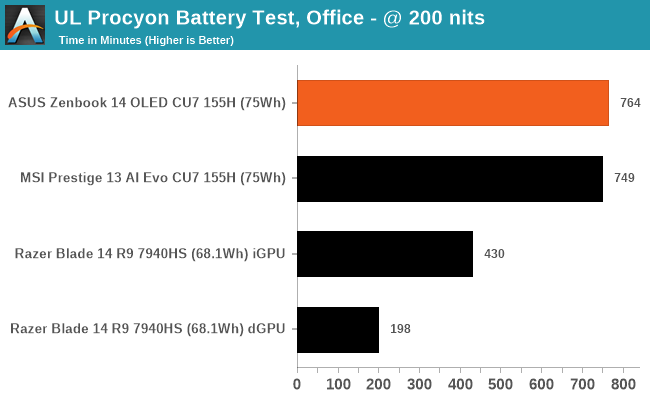
Using UL Procyon's office-focused battery test, we got up to 890 minutes of battery life on the ASUS Zenbook 14 OLED before the battery was fully depleted. The test itself is quite intensive, with numerous Microsoft Office 365-based workloads in the foreground and background. Compared to the MSI Prestige 13 AI Evo A1MG, which is also powered by the Core Ultra 7 155H processor and comes with a 75 Wh battery, the ASUS offers 15 minutes of additional battery life.
Charging Time
Included with the ASUS Zenbook 14 OLED UX3405MA ultrabook is a 65 W AC Type-C charger, which is quite compact and, unlike some brands, uses a widely (if not universally) accepted charging connector. It's also relatively low profile, barring the plug, and comes with a smooth cable similar to a 3-pinned cable for a desktop PC. Overall it is very light compared to a charger that comes with a gaming notebook, so portability is assured.
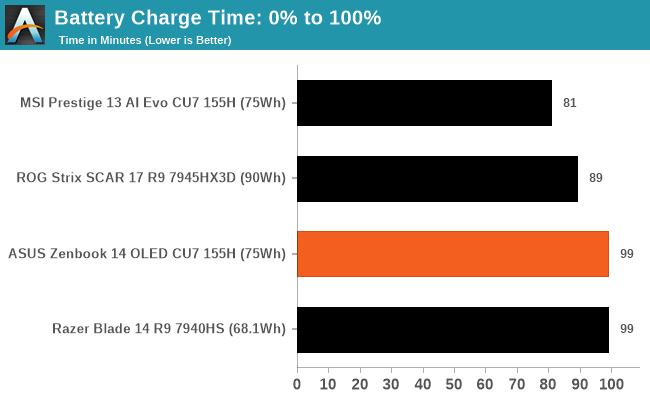
Using the included 65 W Type-C AC charger, the ASUS Zenbook 14 OLED charged from 0% to 100% in 99 minutes, the same time it took to charge the Razer Blade 14 (2023) model. In contrast, it took just 81 minutes to charge the competing MSI Prestige 13 AI Evo A1MG ultrabook.
ASUS Zenbook 14 OLED UX3405MA: Thermal Performance
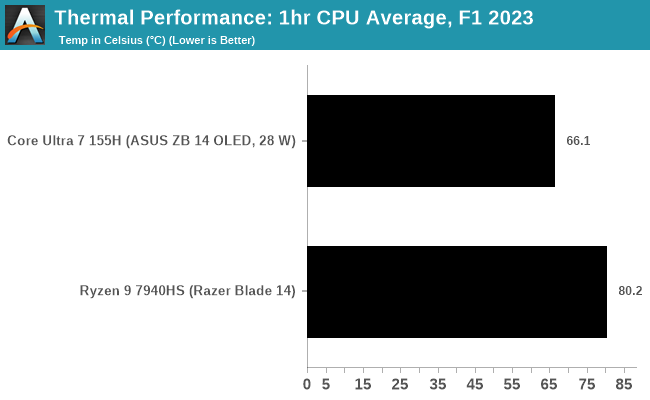
The Intel Core Ultra 7 155H relies solely on integrated graphics, so we're focusing on CPU package temperatures here. Interestingly, the ASUS Zenbook 14 OLED and MSI Prestige 13 Evo with the Core Ultra 7 155H averaged between 66 and 66.5°C, showing that both notebook manufacturers intended this before limitations and throttling kicked in. We know that the power throttles in heavily multi-threaded workloads on the ASUS model from our power analysis, but given the TJ Max is 110°C on the 155H, the reduction in power and temperature is more for the user experience to ensure the notebook chassis isn't burning through your lap.


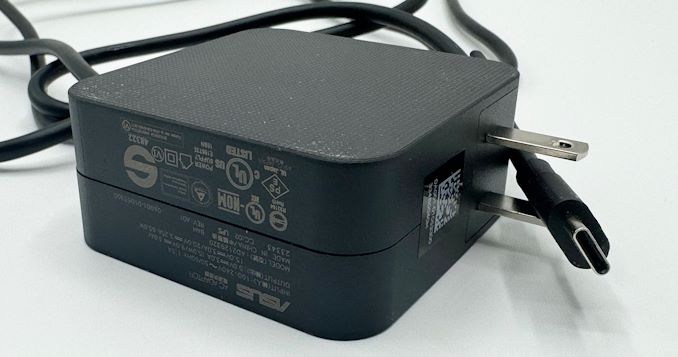








69 Comments
View All Comments
Dante Verizon - Thursday, April 11, 2024 - link
Too strange... in the spec2017 test that represents Blender MeteorLake wins but in the real Blender test it loses? Great ReplyDante Verizon - Thursday, April 11, 2024 - link
The iGPU performance of desktop APUs is also abnormally low. ReplyGavin Bonshor - Friday, April 12, 2024 - link
Could you please elaborate? Did another publication's results land higher? Did they run JEDEC memory settings? Replyballsystemlord - Thursday, April 11, 2024 - link
That near 50% increase in DRAM access latency coupled with the higher thermal limitations is probably what's holding the 115H back. ReplyRyan Smith - Thursday, April 11, 2024 - link
Keep in mind that they're different workloads with different versions of Blender. The version in SPEC2017 is from 7 years ago, which was the Blender 2.7 era. Replymode_13h - Monday, April 15, 2024 - link
spec2017 is using an old version of Blender that's frozen in time. That's needed to make all spec2017 results comparable with each other.In the individual Rendering benchmarks, Gavin used a reasonably current version of Blender (3.6 is a LTS release from June 27, 2023), probably also built with a different compiler. Reply
Hulk - Thursday, April 11, 2024 - link
"AMD Arc" in GPU specs? ReplyGavin Bonshor - Friday, April 12, 2024 - link
Yeah, that was a really weird one. It has since been corrected. ReplyFozzie - Thursday, April 11, 2024 - link
Why is the text seemingly out of line with the actual results? Repeatedly it is describing wins for the U7 155H that don't seem to be backed up in the actual benchmarks. For example:"As we can see from our rendering results, the Intel Core Ultra 7 155H is very competitive in single-threaded performance and is ahead of AMD's Zen 4 mobile Phoenix-based Ryzen 9 7940HS."
Actually, the graphs don't show a single instance of the Ultra 7155H besting the Ryzen 9 7940HS in ALL of the preceding graphs.
"Looking at performance in our web and office-based testing, in the UL Procyon Office-based tests using Microsoft Office, the Core Ultra 7 155H is actually outperforming the AMD Ryzen 9 7940HS, which is a good win in itself."
How is 6,792 greater than 7,482? How is 6,978 higher than 7,162?
Did the benchmarks get updated after the text was written? Did someone write the summary text and not pay attention to "Higher is better" vs "Lower is better"? Reply
phoenix_rizzen - Thursday, April 11, 2024 - link
The text describing the Spec tests are also incorrect."Even though the Core Ultra 7 155H is technically an SoC, it remains competitive in the SPECint2017 section of our single-thread testing against the Ryzen 9 7940HS. The AMD chip performs better in two of the tests (525.x264_r and 548.exchange2_r); on the whole, Intel is competitive."
Except the graph shows the AMD system beating the Intel system in 7 tests and only losing by a small margin in 3 of them. The AMD system even beats the Intel desktop system in 4 tests and ties it in 1.
"In the second section of our single-threaded testing, we again see a very competitive showing in SPECfp2017 between the Intel Core Ultra 7 155H and the AMD Ryzen 9 7940HS. The only test we see a major gain for the Ryzen 9 7940HS is in the 503.bwaves_r test, which is a computational fluid dynamics (CFD) simulation."
Except the AMD system wins in 4 tests, essentially ties in 5 tests, and only loses in 2. It even beat the desktop system in 3 tests.
The text is nowhere near consistent with the graphs. Reply